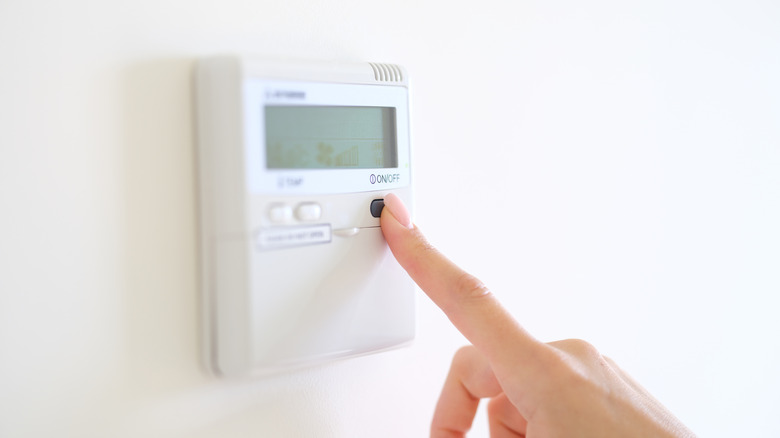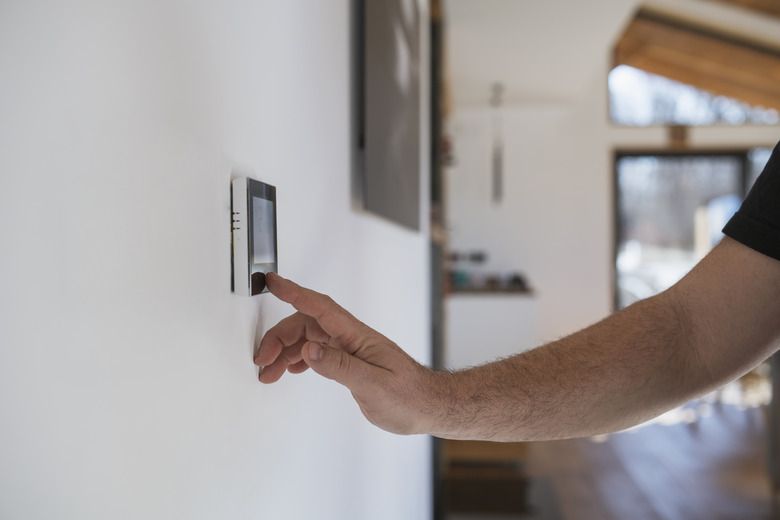How To Fix A Honeywell Thermostat That Does Not Maintain Its Heat Setting
Raise your hand if you've had a programmable Honeywell thermostat for years but don't understand it completely. If you raised your hand, look around and you'll see that you're not alone. A common reason for a Honeywell thermostat not working — probably the most common reason — is the homeowners' failure to set the controls properly. Here's a typical scenario:
You program the device to shut down the heating system when the temperature reaches 64 degrees Fahrenheit, but during a cold streak, you increase the temperature to a more comfortable 68 only to wake up to a cold 64 degrees the following morning. Don't worry ... there's no ghost in the house (ghosts like it cold), and there's nothing wrong with the thermostat. This particular problem is easy to fix.
None of this is to say that a Honeywell thermostat can't malfunction for reasons other than user error. It definitely can, but often, the reason isn't due to the thermostat itself. Perhaps it has a low battery or improper or loose wiring, or it isn't properly sensing room temperature because it's in a poor location, such as a sunny spot, behind a bookcase, or in the path of a draft. On rare occasions, it is possible for the sensor to go bad, and that's one of the few thermostat problems that usually calls for a new thermostat.
To make your Honeywell thermostat hold its heat setting, use the "Permanent Hold" function. The procedure varies from model to model.
Honeywell Thermostat Temporary Hold and Permanent Hold
Honeywell Thermostat Temporary Hold and Permanent Hold
The reason a programmable thermostat reverts to its previous setting without any input from you is usually simple: You used the temporary hold function, not the permanent hold function, when you changed the setting.
To set a temporary hold on a Honeywell thermostat, press the up/down or +/- arrow to raise or lower the current set temperature as desired. The words "Temporary Hold" will be displayed on the screen. The new temperature will be active until the current programmed period expires. On some Honeywell models, you can also set a time for the temporary hold to expire. For example, if the regular program is set for 65 degrees until 5:00 p.m., but you want to raise the temperature to 68 degrees until 3:00 p.m., you can set 3:00 p.m. as the time to change back to 65 degrees.
The maximum temporary hold period you can set is typically less than 12 hours. If you want to override the programmed thermostat setting for longer than that, you have to use the permanent hold feature. To set permanent hold, press the up/down or +/- arrow to change the temperature, then press the "Hold" button to display "Permanent Hold" on the screen. The new temperature setting will remain active until you change it.
On some touchscreen models, you'll get the message "Hold Until" when you press the up/down buttons. In this case, you simply enter the time if you want a temporary hold, but if you want a permanent hold, you touch the message on the screen or the button next to it, and you'll get a "Permanent Hold" option that you can select.
How Can You Tell Your Thermostat Is Not Holding the Temperature?
How Can You Tell Your Thermostat Is Not Holding the Temperature?
Now that you know how to override the program on your thermostat and permanently enter a new temperature setting, you shouldn't have to worry about a ghostly reversion to the programmed setting. However, there are other reasons for a Honeywell thermostat not working as you intended, and most have more to do with programming and maintenance than with a thermostat malfunction.
- The program needs to be changed: Some programmable thermostats allow you to program different temperatures for different times of the day and/or different days of the week. If the current settings aren't to your liking, follow the user manual instructions to reprogram the thermostat.
- Low battery: If the thermostat display is dim or the screen is blank, the thermostat batteries may not have enough power to maintain the temperature settings. It's time to change the batteries, and when you do this, you may have to reprogram.
- The wrong function is selected: You may have the thermostat set to "Fan" rather than "Heat." If you have a reversing heat pump or the thermostat controls an air conditioner or cooling system as well as a heating system, you may have selected "Cool On" rather than "Heat On" (or vice versa in the summer).
- HVAC system problems: A dirty air filter may be inhibiting airflow, there may be an obstruction in the air handler, or the blower may not be working properly.
Honeywell Thermostat Troubleshooting for Heat Settings
Why Do I Feel Cold?
If you've done everything right and you still suspect the room temperature is chronically lower than the thermostat setting, get a room thermometer and take temperature readings near the thermostat and in another part of the room. If the temperature near the thermostat is higher than temperature elsewhere in the room, look for the reason. The thermostat may be in direct sun for part of the day, air from one of the registers may be circulating around it, or you may have created a microclimate around the thermostat by covering it with drapes or a piece of furniture.
Why Does Nothing Happen When I Turn On the Thermostat?
Every thermostat has a five- to seven-minute delay mode and a 2- to 5-degree deadband to prevent the heating system from short cycling (turning on and off too frequently) and causing equipment damage. If nothing happens after the delay period, try setting the temperature several degrees higher, and if nothing happens, try the reset button if your thermostat has one (you'll have to reprogram after using this button). Finally, check the circuit breaker to see if it has tripped; if not, call an HVAC technician to investigate.
Why Does the Air Conditioning Come On When I Select "Heat"?
This is a problem with the thermostat wiring. While you can rewire the thermostat yourself assuming all the wires are the standard colors, there's no guarantee they have all been connected to the proper terminals on the transformer. You can damage your HVAC unit by making a mistake with the wiring, so this is another case where it's best to call an HVAC technician.

